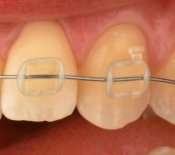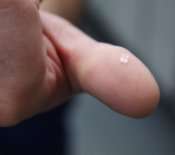Nanoparticles provide reinforcement for invisible brackets in orthodontics

Investigadores de la Universidad Carlos III de Madrid (UC3M) colaboran con la empresa CEOSA-Euroortodoncia en el desarrollo de una nueva generación de brackets de plástico transparente con nanopartículas que aumentan la resistencia y mejoran las propiedades del material.
Los brackets de polímeros plásticos transparentes utilizados en las ortodoncias dentales correctoras han dado muy buen resultado en los últimos años, sobre todo por la mejora estética que suponen respecto a los metálicos, pero presentan ciertos problemas de desgaste en la boca. "Estimamos la fuerza que hacen los dientes en el bracket y se nos ocurrió que la nanotecnología podría resultar útil para solucionar esta cuestión", comenta Juan Baselga, responsable del grupo de Polímeros y Composites de la UC3M. La solución que han ideado es utilizar unas nanopartículas muy duras de alúmina y dispersarlas de forma homogénea en la polisulfona, la matriz de polímero que emplea CEOSA-Euroortodoncia para la fabricación industrial de los brackets.
This new process, patented by the company and the UC3M researchers, has produced a new material which increases mechanical as well as friction resistance, thereby maintaining the brackets' transparency. "We have been able to develop a more rigid material with this technology which has a clearly improved friction resistance, thus helping to withstand the wear and tear produced by the teeth or by chewing, Professor Baselga explained. In addition, it is biocompatible, which is essential for something that is going to be used in the mouth, and complies with European requirements for products which are in contact with food.

Este nuevo tipo de materiales - los plásticos nanoreforzados - encuentran aplicaciones en diversos campos de la industria, según los investigadores. En concreto, la polisulfona resulta interesante en el área biosanitaria por su biocompatibilidad en desarrollos de equipos medico quirúrgicos, donde es preciso mejorar la rigidez y la resistencia a la abrasión. Además, también encuentra potenciales aplicaciones en la industria del automóvil o en el campo de la seguridad; por ejemplo, en el desarrollo de nuevos visores en los cascos de los bomberos.
Esta innovación permite la incorporación y dispersión homogénea de nanopartículas a una matriz polimérica en muy baja proporción. Tras este proceso basado en técnicas químicas verdes que realizan los investigadores de la UC3M, en la empresa CEOSA-Euroortodoncia mezclan las partículas ya dispersas con el polímero mediante técnicas de micro-extrusión y micro-inyección para fabricar la pieza final. "Nosotros dosificamos el plástico, pues las máquinas normales lo mínimo que pueden inyectar son unos 15 gramos, cuando nuestras piezas pueden pesar 0,06 gramos… sería algo así como intentar inyectar insulina con una jeringa de caballo", ilustra el director de la compañía, Alberto Cervera. "Y con la tecnología que estamos utilizando, la micro-extrusión y la micro-inyección, somos capaces de controlar con extrema precisión estas cantidades minúsculas de material", añade.
These new types of materials- nano-reinforced plastics- have applications in diverse areas of industry, according to the researchers. In particular, polysulfone is of interest in the bio-health field because of its bio-compatibility in the development of medical- surgical equipment, where it is of the essence to improve rigidity and friction resistance. Furthermore, it has potential applications in the auto industry and in the area of safety such as, for example, the development of a new visor for firefighters.
This innovation allows nanoparticles to be incorporated and evenly dispersed in a polymer mould in a very low proportion. After this process that is based on green chemical techniques is carried out by UC3M researchers, the particles, which are now dispersed in the polymer through micro-extrusion and micro-injection techniques, are then mixed to produce the final piece in the CEOSA-Euroortodoncia . " We measure out the plastic since the minimum that a normal machine can inject is 15 grams, whereas our pieces weigh .06 grams…it would be akin to injecting insulin with a horse syringe", explained the company director, Alberto Cervera. "And with the technology we are using, micro-extrusion and the micro-injection, we are capable of controlling these minuscule quantities of material with the utmost precision," he added.
The relationship between UC3M and CEOSA/Euroortodoncia takes advantage of the synergy between the public and private sector. "We are a small to medium-sized enterprise and we get support from the University to produce a first rate product, which is then advantageous in the agreements which we have had for a decade in the form of end-of-degree-projects, doctorial theses and joint research programs within the European Union and in the Madrid Autonomous Community, for example," Alberto Cervera ellaborated. "We learn a lot from this collaboration," continued Juan Baselga, "because this company presented us with real problems that they face in their industrial area and they open up their laboratories to our needs."
Patents and innovated application are clear examples of the knowledge and technology transfer that UC3M promotes through the Science Park. One hundred and twenty-five research groups and various laboratories all work so that this innovation is possible. All of this, together with their own technological portfolio, shows the capacity of the University for collaboration with business, industry and institutions.
Provided by Carlos III University of Madrid
















